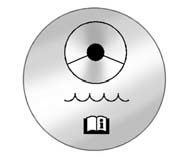Power Steering Fluid

See Engine Compartment Overview for reservoir location.
When to Check Power Steering Fluid
It is not necessary to regularly check power steering fluid unless a leak is suspected in the system or unusual noise is heard. A fluid loss in this system could indicate a problem. Have the system inspected and repaired.
How to Check Power Steering Fluid
Notice: Extremely small amounts of contamination can cause steering
system damage and cause it to not work properly.
Do not allow contaminants to contact the fluid side of the reservoir
cap/dipstick or to enter the reservoir.
To check the power steering fluid:
1. Turn the engine off and let the engine compartment cool down.
2. Remove the engine cover, if required. See Engine Cover.
3. Wipe the cap and the top of the reservoir clean.
4. Unscrew the cap and wipe the dipstick with a clean rag.
5. Replace the cap and completely tighten it.
6. Remove the cap again and look at the fluid level on the dipstick.
The level should be within the HOT mark. If necessary, add only enough fluid to bring the level within the mark.
What to Use
To determine what kind of fluid to use, see Recommended Fluids and Lubricants. Always use the proper fluid.
See also:
Calling for Service
When calling Roadside Service,
have the following information
ready:
- Your name, home address, and
home telephone number.
- Telephone number of your
location.
- Location of the vehicle.
- ...
ELECTRONIC KEY NOT
DETECTED RESTART
ALLOWED
If the vehicle has the keyless
access system, this message
displays when the keyless access
transmitter is not detected inside the
vehicle while you are trying to turn
the ignition off. The ...
Operation and Displays
The DIC has different displays which can be accessed by pressing the DIC buttons
located on the instrument panel, next to the steering wheel.
The DIC displays trip, fuel, and vehicle system informa ...






